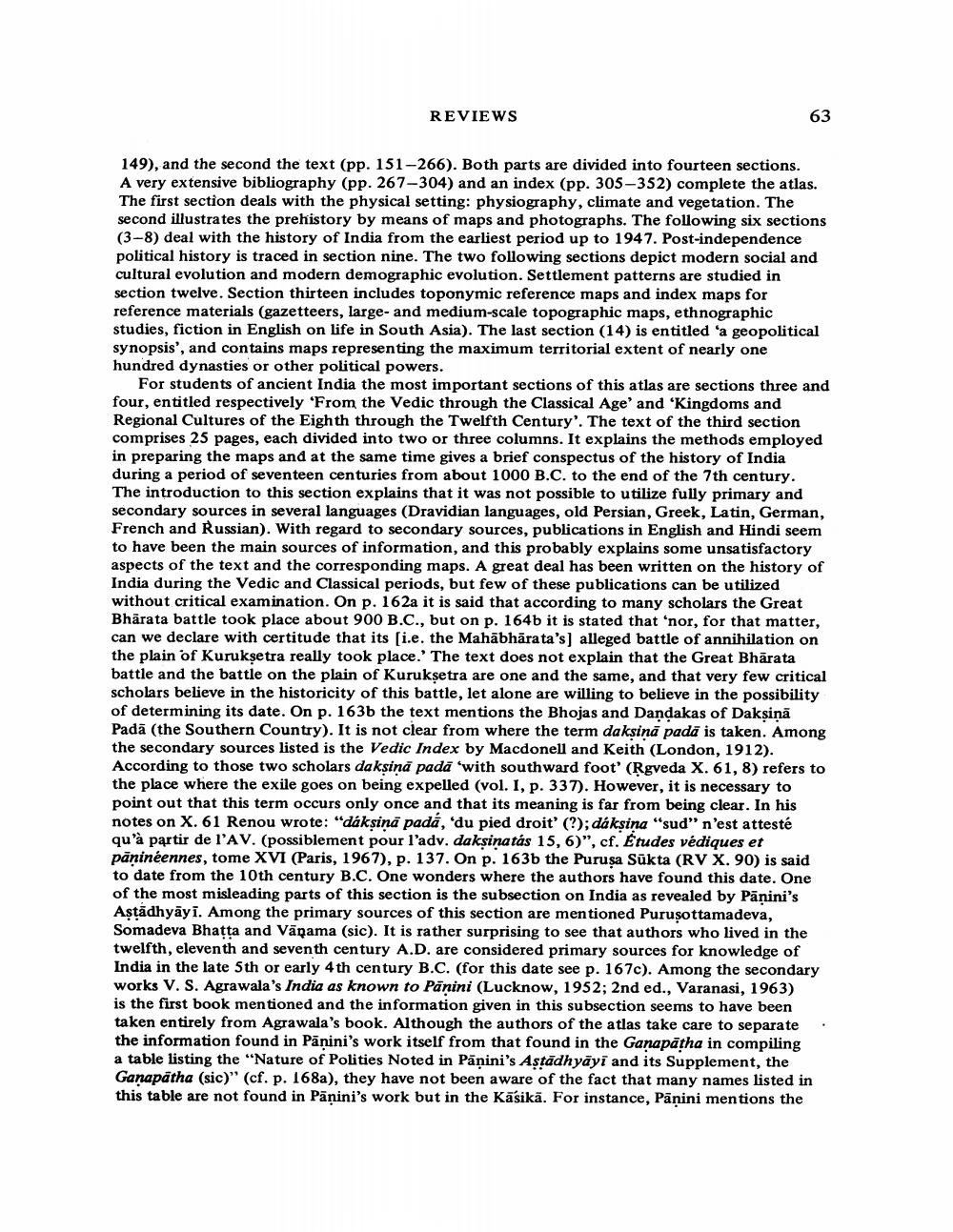Book Title: Book Reviews Author(s): J W De Jong Publisher: J W De Jong View full book textPage 5
________________ REVIEWS 63 149), and the second the text (pp. 151-266). Both parts are divided into fourteen sections. A very extensive bibliography (pp. 267-304) and an index (pp. 305-352) complete the atlas. The first section deals with the physical setting: physiography, climate and vegetation. The second illustrates the prehistory by means of maps and photographs. The following six sections (3-8) deal with the history of India from the earliest period up to 1947. Post-independence political history is traced in section nine. The two following sections depict modern social and cultural evolution and modern demographic evolution. Settlement patterns are studied in section twelve. Section thirteen includes toponymic reference maps and index maps for reference materials (gazetteers, large- and medium-scale topographic maps, ethnographic studies, fiction in English on life in South Asia). The last section (14) is entitled 'a geopolitical synopsis', and contains maps representing the maximum territorial extent of nearly one hundred dynasties or other political powers. For students of ancient India the most important sections of this atlas are sections three and four, entitled respectively "From the Vedic through the Classical Age' and 'Kingdoms and Regional Cultures of the Eighth through the Twelfth Century'. The text of the third section comprises 25 pages, each divided into two or three columns. It explains the methods employed in preparing the maps and at the same time gives a brief conspectus of the history of India during a period of seventeen centuries from about 1000 B.C. to the end of the 7th century. The introduction to this section explains that it was not possible to utilize fully primary and secondary sources in several languages (Dravidian languages, old Persian, Greek, Latin, German, French and Russian). With regard to secondary sources, publications in English and Hindi seem to have been the main sources of information, and this probably explains some unsatisfactory aspects of the text and the corresponding maps. A great deal has been written on the history of India during the Vedic and Classical periods, but few of these publications can be utilized without critical examination. On p. 162a it is said that according to many scholars the Great Bhärata battle took place about 900 B.C., but on p. 164b it is stated that 'nor, for that matter, can we declare with certitude that its [i.e. the Mahābhārata's) alleged battle of annihilation on the plain of Kuruksetra really took place. The text does not explain that the Great Bhārata battle and the battle on the plain of Kuruksetra are one and the same, and that very few critical scholars believe in the historicity of this battle, let alone are willing to believe in the possibility of determining its date. On p. 163b the text mentions the Bhojas and Dandakas of Daksiņā Padā (the Southern Country). It is not clear from where the term daksinā pada is taken. Among the secondary sources listed is the Vedic Index by Macdonell and Keith (London, 1912). According to those two scholars daksina padā 'with southward foot' (Rgveda X.61, 8) refers to the place where the exile goes on being expelled (vol. I, p. 337). However, it is necessary to point out that this term occurs only once and that its meaning is far from being clear. In his notes on X. 61 Renou wrote: "dákşină padá, du pied droit' (?); dáksina "sud" n'est attesté qu'à partir de l'AV. (possiblement pour l'adv. daksinatás 15, 6)", cf. Etudes védiques et pāninéennes, tome XVI (Paris, 1967), p. 137. On p. 163b the Purusa Sukta (RV X. 90) is said to date from the 10th century B.C. One wonders where the authors have found this date. One of the most misleading parts of this section is the subsection on India as revealed by Pānini's Astädhyāyi. Among the primary sources of this section are mentioned Purusottamadeva, Somadeva Bhatta and Vänama (sic). It is rather surprising to see that authors who lived in the twelfth, eleventh and seventh century A.D. are considered primary sources for knowledge of India in the late 5th or early 4th century B.C. (for this date see p. 167c). Among the secondary works V. S. Agrawala's India as known to Panini (Lucknow, 1952; 2nd ed., Varanasi, 1963) is the first book mentioned and the information given in this subsection seems to have been taken entirely from Agrawala's book. Although the authors of the atlas take care to separate . the information found in Panini's work itself from that found in the Ganapatha in compiling a table listing the "Nature of Polities Noted in Pāņini's Astādhyāyi and its Supplement, the Ganapatha (sic)" (cf. p. 168a), they have not been aware of the fact that many names listed in this table are not found in Pänini's work but in the Käsikä. For instance, Pāṇini mentions thePage Navigation
1 ... 3 4 5 6 7 8 9 10 11 12 13 14 15 16 17 18 19 20 21 22 23 24 25 26 27 28 29 30 31 32 33 34 35 36 37 38 39
